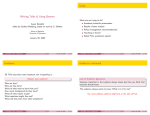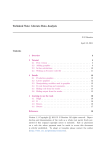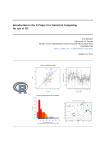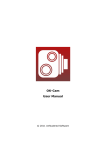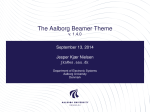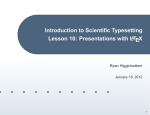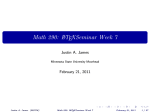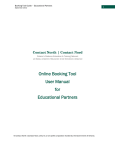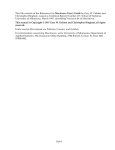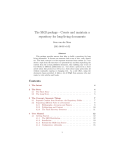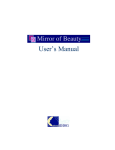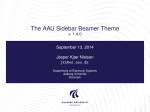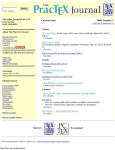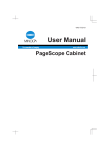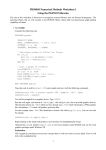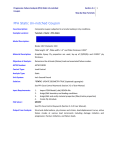Download Writing Talks & Using Beamer
Transcript
Goals
Writing Talks & Using Beamer
What are we trying to do?
Academic/scientific presentation
Aaron Rendahl
slides by Gary W. Oehlert, rev. S. Weisberg
Results of data analysis
Policy/management recommendations
School of Statistics
University of Minnesota
Teaching or lecture
Nobel Prize acceptance speech
January 25, 2010
STAT8801 (Univ. of Minnesota)
Writing Talks & Using Beamer
January 25, 2010
1/1
Audience
STAT8801 (Univ. of Minnesota)
Writing Talks & Using Beamer
January 25, 2010
2/1
Audience continued
Ed Tufte says that most important rule of speaking is:
Law of Audience Ignorance
Respect your audience!
Someone important in the audience always knows less than you think that
everyone should know.
Who are they?
Why are they here?
What do they need to learn from you?
How much background do they have?
What do they expect to get?
What questions might they ask?
What will they learn from other presenters?
STAT8801 (Univ. of Minnesota)
Writing Talks & Using Beamer
The audience always wants to know “What’s in it for me?”
You must address audience objectives or the talk will fail.
January 25, 2010
3/1
STAT8801 (Univ. of Minnesota)
Writing Talks & Using Beamer
January 25, 2010
4/1
How much time do you have?
Things to know
You must:
Never speed up!
Assume everyone is busy
You must:
Know your subject matter!
No need to tell everything you know
You must:
About one slide/overhead per minute
Know your limitations!
You must:
Never blame the audience!
STAT8801 (Univ. of Minnesota)
Writing Talks & Using Beamer
January 25, 2010
5/1
Organize
STAT8801 (Univ. of Minnesota)
Writing Talks & Using Beamer
January 25, 2010
6/1
January 25, 2010
8/1
Structure of a basic talk
This works most of the time
1
Determine the objective/goal of talk
Tell them what you are going to say,
then say it,
then tell them what you said.
2
Analyze the audience; you say different things to scientists, juries or
bus drivers.
Or ...
3
Identify takeaway message; build presentation around it
Get their attention, let them have it, then drive it home.
4
Organize your information; match content and structure to audience
and objective
Approach the talk logically:
5
Choose a look for presentation
1
Set up (opening)
2
Say it (body)
3
Repeat and conclude (summary)
Repetition not a vice.
STAT8801 (Univ. of Minnesota)
Writing Talks & Using Beamer
January 25, 2010
7/1
STAT8801 (Univ. of Minnesota)
Writing Talks & Using Beamer
Set up
At the start: The Introduction
The most memorable parts are beginning and end; make them work for
you.
Announce your topic clearly and state objective
Using an outline of the talk is often recommended, but I don’t do it.
Introductions can benefit from:
Personal anecdotes
Outline should be understandable by itself
Visual imagery
Don’t need abstract
Quotes
Let audience know importance and why they should care
Facts
Questions
Challenge
STAT8801 (Univ. of Minnesota)
Writing Talks & Using Beamer
January 25, 2010
9/1
At the end: The summary
STAT8801 (Univ. of Minnesota)
Writing Talks & Using Beamer
January 25, 2010
10 / 1
Structure of Case Study talks
You may decide to vary the order of some of these elements in any talk,
and you don’t need all of them for every talk.
Summarize and refer back to opener
1
Introduce the problem. For the class, this should be short because
everyone has seen the case study. Generally, it needs to engage the
audience.
2
Key takeaway message
3
Objectives
4
What you did: Models and Methodology (brief!)
5
Findings and implications
6
Recommendations
Link with key points/ideas
Be ready for questions
STAT8801 (Univ. of Minnesota)
Writing Talks & Using Beamer
January 25, 2010
11 / 1
STAT8801 (Univ. of Minnesota)
Writing Talks & Using Beamer
January 25, 2010
12 / 1
Technical talk
Back to School
Five things listener wants to know
Grammar
1
What is problem and why is it a problem
Spelling
2
What has been done about it before
Emphasis
3
What is presenter doing about it
Repetition
4
What is added value of presenter’s approach
Examples
5
Where do we go from here
6
. . . bibliographies, extra material for use with questions can be helpful
STAT8801 (Univ. of Minnesota)
Writing Talks & Using Beamer
January 25, 2010
13 / 1
Stage Presence
Practice! Practice! Practice! (and get feedback)
STAT8801 (Univ. of Minnesota)
Writing Talks & Using Beamer
January 25, 2010
14 / 1
Meetings
You should be
1
Positive, confident, enthusiastic
2
Facing the audience; make eye contact
Check location of room.
3
Speak slowly
Arrive early
4
Using a microphone is not a sign of personal weakness!
Meet session chair
5
Be careful with laser pointers, hold them steady
Stay whole session
6
Use humor wisely
Understand equipment: computers, projectors, microphones
7
Try to involve the audience
8
Use short simple phrases with no filler words like “Note that” or “It is
obvious that”
STAT8801 (Univ. of Minnesota)
Writing Talks & Using Beamer
January 25, 2010
15 / 1
STAT8801 (Univ. of Minnesota)
Writing Talks & Using Beamer
January 25, 2010
16 / 1
Chairing a session
Preparing your talk
At meetings, four to six similar presentations are grouped together into a
single session, with a “chairperson” who runs the session. As chair, you
should
Apart from classroom teaching, using computer presentations is almost
universal.
PowerPoint and pdf-using-LATEX:
Arrive early and meet all the speakers
Can look quite good
Understand equipment: computers, projectors, microphones
Can use hi-res graphics, animations, etc.
Begin on time, with a brief welcome and introduction of the topic
Often easy to make handouts
Introduce each speaker briefly, but try to do more than just name and
affiliation.
Still not universal
Thank each speaker before introducing the next one.
High failure rate
After all speakers, if time permits, ask for audience questions and
moderate.
Preparation time
Tendency for medium to be message
End on time. Have the audience thank all speakers with applause.
STAT8801 (Univ. of Minnesota)
Writing Talks & Using Beamer
But
January 25, 2010
17 / 1
Tufte’s dissent
STAT8801 (Univ. of Minnesota)
Writing Talks & Using Beamer
January 25, 2010
18 / 1
January 25, 2010
20 / 1
PowerPoint
PowerPoint is a competent slide manager and projector. But rather than
supplementing a presentation, it has become a substitute for it.
Ubiquitous
Large user base
The presentation needs
Stinks at mathematics, but. . .
Content
Extremely easy to use if no mathematics
Simple, logical structure
PowerPoint cost money, but free versions exist
Appropriate detail
Check http://www.norvig.com/Gettysburg/
Appropriate emphasis
Does not need fancy animations, transitions, etc.
STAT8801 (Univ. of Minnesota)
Writing Talks & Using Beamer
January 25, 2010
19 / 1
STAT8801 (Univ. of Minnesota)
Writing Talks & Using Beamer
LATEX
Beamer
Available on most platforms
These slides were prepared with the Beamer package in LATEX.
AT Xfile mystuff.tex on class webpage
1 L
E
Great at math
Great flexibility
Mostly academic user base
Harder to use beyond basics than PowerPoint
beamer, and other, packages designed to create talks
2
Fill mystuff.tex with Beamer commands
3
pdflatex mystuff.tex on Linux produces mystuff.pdf
4
Use evince, okular, or another pdf viewer
Links to user manual and other useful documents are on the class web
page, including advice for Windows.
Great flexibility (also bad)
Multimedia much harder
STAT8801 (Univ. of Minnesota)
Writing Talks & Using Beamer
January 25, 2010
21 / 1
Beamer, top information
STAT8801 (Univ. of Minnesota)
Writing Talks & Using Beamer
January 25, 2010
22 / 1
Beamer title and table of contents
\documentclass{beamer}
\usepackage{wasysym,graphicx,pgfpages}
\usetheme{Boadilla}
\begin{document}
\title{Oral Presentation}
\author{Ima G. Student}
\date{January 22, 2008}
%
(see man colors on Linux for list of colors)
\definecolor{maroon}{rgb}{.6902,.1882,.3765}
\definecolor{sienna}{rgb}{.53,.31,.16}
\definecolor{gold}{rgb}{1,.84314,.0000}
\setbeamercolor{frametitle}{fg=maroon,bg=gold}
\usecolortheme[named=maroon]{structure}
STAT8801 (Univ. of Minnesota)
Writing Talks & Using Beamer
January 25, 2010
\frame{\titlepage}
%create titlepage
\frame{\tableofcontents} %create table of contents page
\section{Name of first section in table of contents}
Entries in the table of contents are generated by \section{} commands
23 / 1
STAT8801 (Univ. of Minnesota)
Writing Talks & Using Beamer
January 25, 2010
24 / 1
Beamer example, continued
This is the frame title
\begin{frame}
\frametitle{This is the frame title}
\begin{block}{This is a block title}
This is the block content.
\end{block}
This is a block title
This is the block content
This appears after the pause:
\pause
This appears after the pause:
\[
E(y|x) = \beta_0 + \beta_1x
\]
E (y |x) = β0 + β1 x
This is an alert in the alert color.
\alert{This is an alert in the alert color.}
\end{frame}
STAT8801 (Univ. of Minnesota)
Writing Talks & Using Beamer
January 25, 2010
25 / 1
Frames with computer output:
STAT8801 (Univ. of Minnesota)
Writing Talks & Using Beamer
January 25, 2010
26 / 1
Some computer output
Use verbatim for computer output.
This requires making the frame containsverbatim.
\begin{frame}[containsverbatim]
\frametitle{Some computer output}
This has computer output:
\begin{verbatim}
Coefficients:
Estimate Std. Error t
(Intercept) 90.9609
37.3532
Pressure
0.7650
0.6608
Lpres
0.6649
0.3859
\ end{verbatim}
\end{frame}
STAT8801 (Univ. of Minnesota)
This has computer output:
Coefficients:
Estimate Std. Error t value Pr(>|t|)
(Intercept) 90.9609
37.3532
2.435
0.0289 *
Pressure
0.7650
0.6608
1.158
0.2664
Lpres
0.6649
0.3859
1.723
0.1069
value Pr(>|t|)
2.435
0.0289 *
1.158
0.2664
1.723
0.1069
Writing Talks & Using Beamer
January 25, 2010
27 / 1
STAT8801 (Univ. of Minnesota)
Writing Talks & Using Beamer
January 25, 2010
28 / 1
More beamer
Beamer and Sweave
You can use Beamer and Sweave at the same time to use R output in your
presentation.
Use itemize, description, and enumerate environments.
To include graphics, save as pdf or png (or others), and use, for
example
1
Name your main file myfile.Rnw rather than myfile.tex
2
Create .tex file with R CMD Sweave myfile.Rnw or the Sweave.sh
script, found at
http://cran.r-project.org/contrib/extra/scripts/
3
Create .pdf file with pdflatex myfile.tex
4
View the resulting .pdf file with a pdf viewer.
5
Links to Sweave documentation on class website
\includegraphics[width=.8\textwidth]{mypic.pdf}
You can create pdf graphics in R using the pdf() device:
> pdf("mypic.pdf")
> plot(Y~X,dataframe)
> dev.off()
STAT8801 (Univ. of Minnesota)
Writing Talks & Using Beamer
January 25, 2010
29 / 1
Sweave, text only, set containsverbatim option
STAT8801 (Univ. of Minnesota)
Writing Talks & Using Beamer
January 25, 2010
30 / 1
Using xtable
\<<echo=TRUE>>=
library(alr3)
data(forbes)
m1 <- lm(Lpres~Temp,forbes)
summary(m1)$coef
\@
The xtable package outputs data in LATEX format:
|
|
|
|
Produces this:
> library(alr3)
> data(forbes)
> m1 <- lm(Lpres ~ Temp, forbes)
> summary(m1)$coef
<<echo=FALSE,results=tex>>=
library(xtable)
xtable(summary(m1)$coef)
@
Produces:
(Intercept)
Temp
Estimate
-42.14
0.90
Std. Error
3.34
0.02
t value
-12.62
54.43
Pr(>|t|)
0.00
0.00
Estimate Std. Error
t value
Pr(>|t|)
(Intercept) -42.1377793 3.34019890 -12.61535 2.175977e-09
Temp
0.8954937 0.01645176 54.43147 1.186078e-18
STAT8801 (Univ. of Minnesota)
Writing Talks & Using Beamer
January 25, 2010
31 / 1
STAT8801 (Univ. of Minnesota)
Writing Talks & Using Beamer
January 25, 2010
32 / 1
Draw graphics
Draw a graph automatically
> plot(Lpres ~ Temp, forbes)
> abline(m1)
Name the section of output, for example:
\<<one,echo=TRUE,fig=TRUE,include=TRUE>>=
plot(Lpres~Temp,forbes)
abline(m1)
\@
●
●
●
145
●
creates a file called mystuff1-one.pdf because fig=TRUE, and then
automatically prints it in the presentation because include=TRUE.
●
Lpres
alertHint: When using lattice graphics, you must use a command like
140
●
●
print(xyplot(Lpres~Temp,data=forbes))
●
●
●●
●
135
STAT8801 (Univ. of Minnesota)
Writing Talks & Using Beamer
January 25, 2010
33 / 1
●
●
●
STAT8801 (Univ. of Minnesota)
Writing Talks & Using Beamer
January 25, 2010
34 / 1
●●
195
Draw a graph but you size it
200
205
210
Create a graph, but youTemp
size it
This graph is automatically sized to be 80% of the width of the page.
●●
145
●
●
●
140
●
●
●
●●●
●●
135
Lpres
\<<two,echo=FALSE,height=4,width=5,fig=TRUE,include=FALSE>>=
plot(Lpres~Temp,forbes)
abline(m1)
\@
●
●
●●
\vspace{-.5in}
195
200
205
210
Temp
\includegraphics[width=0.5\textwidth]{beamer-two.pdf}
Can also use nogin option to documentclass so that size is equal to actual
size, not 80% of width.
STAT8801 (Univ. of Minnesota)
Writing Talks & Using Beamer
January 25, 2010
35 / 1
STAT8801 (Univ. of Minnesota)
Writing Talks & Using Beamer
January 25, 2010
36 / 1
Advice
More advice
Have full references available.
Imitate other Beamer files when making first presentation.
Your name, the date, and contact info should be included
Many pictures, short phrases
Graphs need axis labels and need to be discussed
Simple styles/options are generally better
Keep math to a minimum
Be consistent (don’t keep changing)
Tabled data should be relevant and properly laid out
Beware of gratuitous use of color; some people can’t see colors
STAT8801 (Univ. of Minnesota)
Writing Talks & Using Beamer
January 25, 2010
The beginning of the beamer manual is a good reference for structuring
your beamer document.
37 / 1
Evaluation should always be constructive
STAT8801 (Univ. of Minnesota)
Writing Talks & Using Beamer
January 25, 2010
38 / 1
Be careful with words:
Not so good. . .
Your talk was total rubbish.
”Begin your criticism with a compliment. Remember this fellow has a lot of
time invested in this enterprise, and if your are going to get him to change
what he is doing, you need to convince him that you are on his side.”
—Mosteller, Tukey and Cochran, Statistical Problems of the Kinsey Report
STAT8801 (Univ. of Minnesota)
Writing Talks & Using Beamer
January 25, 2010
39 / 1
Better. . .
I got lost as soon as you started the technical discussion. I couldn’t follow
what you were doing.
Even better. . .
When you set up your model, I could not follow the notation that was
used. It would have helped me if you. . .
STAT8801 (Univ. of Minnesota)
Writing Talks & Using Beamer
January 25, 2010
40 / 1
Big Picture and Details
The Big Picture matters!
1
Were important elements of the talk missing?
2
Could you summarize what you were told in the talk?
3
Was it interesting?
Details matter!
1
Couldn’t hear?
2
Bad notation?
3
Poor English?
4
And so on.
STAT8801 (Univ. of Minnesota)
Writing Talks & Using Beamer
January 25, 2010
41 / 1











